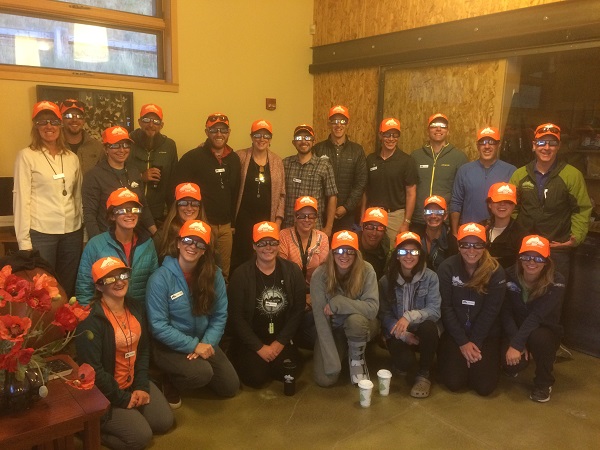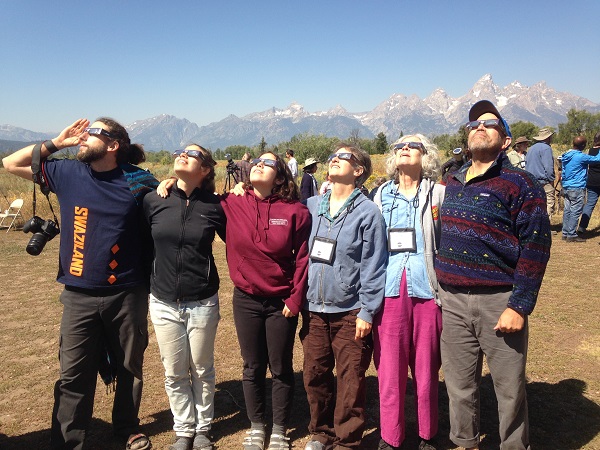Well, here at Teton Science Schools, we shared the total solar eclipse on Monday, August 21st with around 400 guests, brought to the Tetons by our partner TravelQuest International. Here are some scenes from the Jackson and Kelly Campuses, where staff and guests alike connected to this place in an entirely new way. And because this astronomical event turns out to be very hard describe, here are some wise words from Annie Dillard, exerpted from her 1982 essay “Total Eclipse.” The words are somber, the photos are out-of-this-world and maybe even a bit absurd: perhaps therein lies the best description of a total solar eclipse.
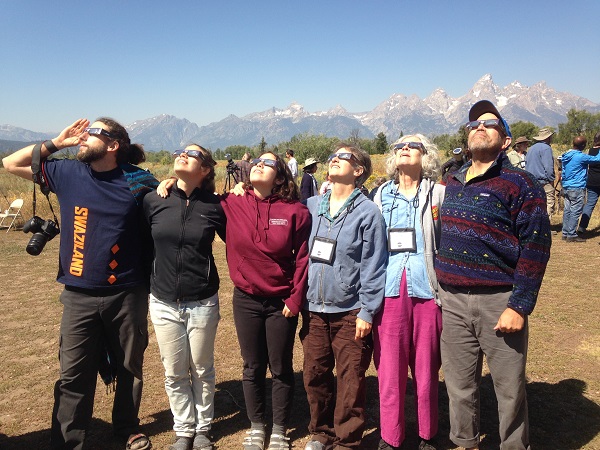
“It began with no ado. It was odd that such a well advertised public event should have no starting gun, no overture, no introductory speaker. I should have known right then that I was out of my depth. Without pause or preamble, silent as orbits, a piece of the sun went away. We looked at it through welders’ goggles. A piece of the sun was missing; in its place we saw empty sky.”
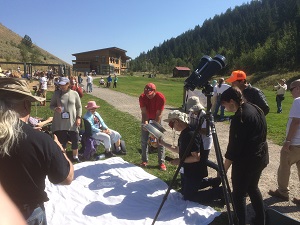 “I had seen a partial eclipse in 1970. A partial eclipse is very interesting. It bears almost no relation to a total eclipse. Seeing a partial eclipse bears the same relation to seeing a total eclipse as kissing a man does to marrying him, or as flying in an airplane does to falling out of an airplane. Although the one experience precedes the other, it in no way prepares you for it. During a partial eclipse the sky does not darken—not even when 94 percent of the sun is hidden. Nor does the sun, seen colorless through protective devices, seem terribly strange. We have all seen a sliver of light in the sky; we have all seen the crescent moon by day. However, during a partial eclipse the air does indeed get cold, precisely as if someone were standing between you and the fire. And blackbirds do fly back to their roosts.”
“I had seen a partial eclipse in 1970. A partial eclipse is very interesting. It bears almost no relation to a total eclipse. Seeing a partial eclipse bears the same relation to seeing a total eclipse as kissing a man does to marrying him, or as flying in an airplane does to falling out of an airplane. Although the one experience precedes the other, it in no way prepares you for it. During a partial eclipse the sky does not darken—not even when 94 percent of the sun is hidden. Nor does the sun, seen colorless through protective devices, seem terribly strange. We have all seen a sliver of light in the sky; we have all seen the crescent moon by day. However, during a partial eclipse the air does indeed get cold, precisely as if someone were standing between you and the fire. And blackbirds do fly back to their roosts.”
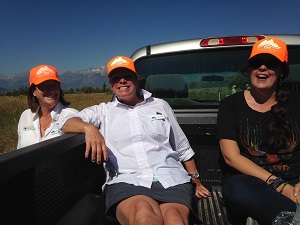 “What you see in an eclipse is entirely different from what you know. It is especially different for those of us whose grasp of astronomy is so frail that, given a flashlight, a grapefruit, two oranges, and 15 years, we still could not figure out which way to set the clocks for daylight saving time. Usually it is a bit of a trick to keep your knowledge from blinding you. But during an eclipse it is easy. What you see is much more convincing than any wild-eyed theory you may know.”
“What you see in an eclipse is entirely different from what you know. It is especially different for those of us whose grasp of astronomy is so frail that, given a flashlight, a grapefruit, two oranges, and 15 years, we still could not figure out which way to set the clocks for daylight saving time. Usually it is a bit of a trick to keep your knowledge from blinding you. But during an eclipse it is easy. What you see is much more convincing than any wild-eyed theory you may know.”
“You may read that the moon has something to do with eclipses. I have never seen the moon yet. You do not see the moon. So near the sun, it is as completely invisible as the stars are by day. What you see before your eyes is the sun going through phases. It gets narrower and narrower, as the waning moon does, and, like the ordinary moon, it travels alone in the simple sky. The sky is of course background. It does not appear to eat the sun; it is far behind the sun. The sun simply shaves away; gradually, you see less sun and more sky.”
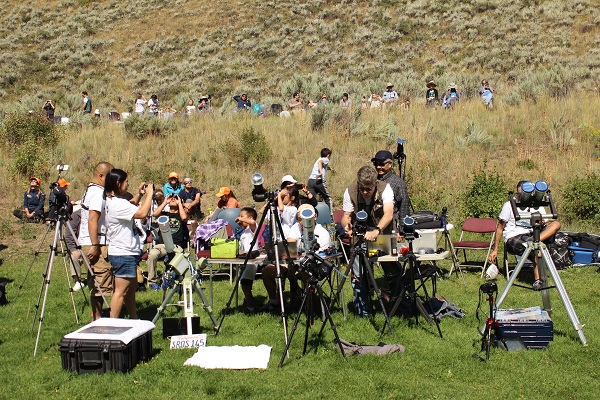
“The sun was going, and the world was wrong. The grasses were wrong; they were platinum. Their every detail of stem, head, and blade shone lightless and artificially distinct as an art photographer’s platinum print. This color has never been seen on Earth. The hues were metallic; their finish was matte. The hillside was a 19th-century tinted photograph from which the tints had faded. All the people you see in the photograph, distinct and detailed as their faces look, are now dead. The sky was navy blue. 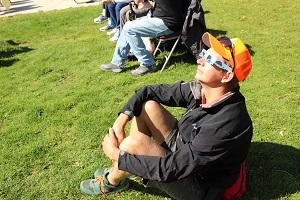 My hands were silver. All the distant hills’ grasses were finespun metal which the wind laid down. I was watching a faded color print of a movie filmed in the Middle Ages; I was standing in it, by some mistake. I was standing in a movie of hillside grasses filmed in the Middle Ages. I missed my own century, the people I knew, and the real light of day.”
My hands were silver. All the distant hills’ grasses were finespun metal which the wind laid down. I was watching a faded color print of a movie filmed in the Middle Ages; I was standing in it, by some mistake. I was standing in a movie of hillside grasses filmed in the Middle Ages. I missed my own century, the people I knew, and the real light of day.”
“At once this disk of sky slid over the sun like a lid. The sky snapped over the sun like a lens cover. The hatch in the brain slammed. Abruptly it was dark night, on the land and in the sky. In the night sky was a tiny ring of light. The hole where the sun belongs is very small. A thin ring of light marked its place. There was no sound. The eyes dried, the arteries drained, the lungs hushed. There was no world.”
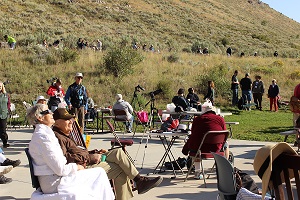 “The world which lay under darkness and stillness following the closing of the lid was not the world we know. The event was over. Its devastation lay around about us. The clamoring mind and heart stilled, almost indifferent, certainly disembodied, frail, and exhausted. The hills were hushed, obliterated. Up in the sky, like a crater from some distant cataclysm, was a hollow ring.”
“The world which lay under darkness and stillness following the closing of the lid was not the world we know. The event was over. Its devastation lay around about us. The clamoring mind and heart stilled, almost indifferent, certainly disembodied, frail, and exhausted. The hills were hushed, obliterated. Up in the sky, like a crater from some distant cataclysm, was a hollow ring.”
“You see the wide world swaddled in darkness; you see a vast breadth of hilly land, and an enormous, distant, blackened valley; you see towns’ lights, a river’s path, and blurred portions of your hat and scarf; you see your husband’s face looking like an early black-and-white film; and you see a sprawl of black sky and blue sky together, with unfamiliar stars in it, some barely visible bands of cloud, and over there, a small white ring.”
